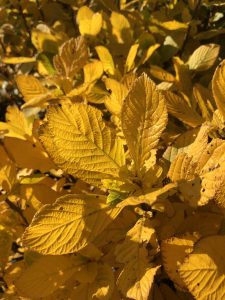Walking around the nursery yesterday, I couldn’t help but notice the overall lack of color. With so many deciduous trees on site, you would think we would have a riot of red, purple, orange and yellow leaves all over the place. Unfortunately, Nantucket’s moderate climate doesn’t usually make for excellent displays of autumn leaves. Most years, we go from a lush green nursery in September to rows and rows of bare twigs by mid November without much fall color in between. I couldn’t help but notice a stunning show of yellow from a group of sweetpepperbush (aka summersweet) in the shrub area today, however. On a dingy autumn afternoon, they really brighten things up.
 Clethra alnifolia, as botanists refer to it, is a native North American plant that is endemic to Nantucket where it can be found growing in low-lying areas and at the edges of wetlands. If grown in moist soil, it tends to sucker and form colonies over time. However, this plant is well-behaved and very adaptable, doing well in most any island garden where average soil and even water is available. It prefers full sun, but will flower in shade. The overall look of these plants is a pleasant green, twiggy shrub with an upright, balloon-shaped habit. They have medium green, rounded, ovate leaves with finely-toothed edges. In mid summer, they produce loads of fragrant flowers that are reminiscent of small, skinny bottle brushes. The native form of this plant generally has white flowers, but there are pink cultivars available, as well. Beneficial insects like it just as much as we do; many species of butterflies, bees, wasps, flies and other flying insects frequent the plant while it is in flower during July and August.
Clethra alnifolia, as botanists refer to it, is a native North American plant that is endemic to Nantucket where it can be found growing in low-lying areas and at the edges of wetlands. If grown in moist soil, it tends to sucker and form colonies over time. However, this plant is well-behaved and very adaptable, doing well in most any island garden where average soil and even water is available. It prefers full sun, but will flower in shade. The overall look of these plants is a pleasant green, twiggy shrub with an upright, balloon-shaped habit. They have medium green, rounded, ovate leaves with finely-toothed edges. In mid summer, they produce loads of fragrant flowers that are reminiscent of small, skinny bottle brushes. The native form of this plant generally has white flowers, but there are pink cultivars available, as well. Beneficial insects like it just as much as we do; many species of butterflies, bees, wasps, flies and other flying insects frequent the plant while it is in flower during July and August.
Clethra can serve many uses in the landscape. If planted in a row, they make a great informal hedge that doesn’t require much pruning to maintain a tight shape. I’ve seen them used very well in mixed shrub borders with both native and ornamental plants. They make natural companions to bayberry, arrowwood, groundsel and beach plum, but look just as well among ornamental plants like butterfly bushes, vitex, shrub roses and spiraea. They respond very well to pruning and can be maintained at a height of five feet or so with an annual pruning. Some gardeners prefer to remove the spent flowers while others leave them on the plant to be covered up by the new growth in spring.
There are many cultivars available in the trade as well as the straight species:
Clethra alnifolia: The species form of this shrub. Generally grows 3-4′ wide and 6 or more feet tall. White flowers.
‘Anne’s Bouquet’: White flowers. Average size.
‘Hummingbird’: Compact, white-flowered form. 2-4′ wide and up to 5′ high.
‘Pink Spires’: Pink-flowered form, average size.
‘Ruby Spice’: Pink flowers, average size.
‘Rosea’: Pink flowers. Average size.
‘Sixteen Candles’: Compact, white-flowered selection with white flowers.
‘Vanilla Spice’: Proven Winners introduction. White flowers, touted to be larger than most. Average size.
